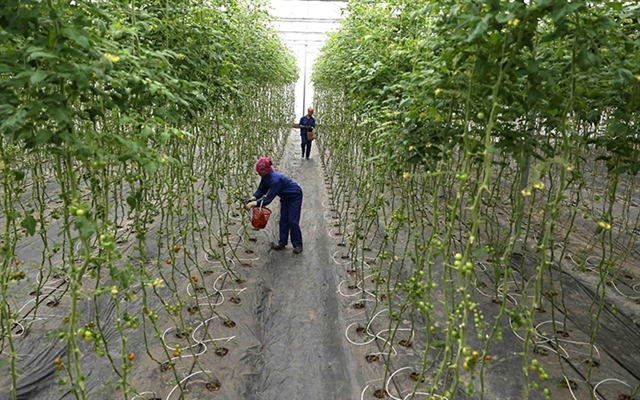 Society
Society

Underdeveloped northern provinces were embracing high technology to make breakthroughs in farming productivity in hopes of lifting locals – mostly of ethnic minorities – out of poverty.

|
| Farmers harvest tomatoes grown in a shade house in Hương Nộn Commune, Tam Nông District, Phú Thọ Province. — Photo nhandan.com.vn |
HÀ NỘI — Underdeveloped northern provinces were embracing high technology to make breakthroughs in farming productivity in hopes of lifting locals – mostly of ethnic minorities – out of poverty.
Đông Sang is a remote commune in Sơn La Province about 200 km west of Hà Nội where seven ethnic minorities live alongside each other. They heavily depend on agriculture as their main source of income.
Communal People’s Committee chairman Phạm Văn Giang told Nhân dân (People) newspaper that the locals started trying out new technologies in farming since 2013 and the results were astounding.
“The application of technology in agriculture has changed the traditional farming methods of the ethnic minorities, raising the average productivity from VNĐ29 million (US$1,200) per ha in 2013 to about VNĐ50 million per ha,” Giang said.
He said that many investors were also flocking to the mountainous commune to set up large-scale high-tech farms since 2018. There were few already yielding promising revenues, between VNĐ800 million and up to VNĐ1 billion ($34,000-$42,500) a year, the official added.
“We believe high tech agriculture is the right way (for development) so the locality will now focus efforts on increasing mechanisation, building large-scale fields and developing models to apply high tech into production.”
Đông Sang is not the only locality in Sơn La looking to modernise the agriculture sector. The whole province, in fact, was rolling out plans to develop and form specific areas for high tech farming to produce high-value and high-quality crops like organic rice, vegetables, tea and coffee, according to Sơn La Department of Agriculture and Rural Development.
The province was aiming to have up to 20 per cent of the total agricultural production value in the province come from high tech agriculture, said the department.
Further up north, in the border province of Lào Cai, the Bắc Hà Commune was a pioneer in applying high tech in agriculture. The locality successfully built up specialised farming zones for unseasonal greenhouse vegetables, high-end fruits and flowers and medicinal plants and herbs like artichoke and Ngọc Linh ginseng.
According to the local Department of Agriculture and Rural Development, there was approximately 150 ha of high tech agriculture across the commune, yielding between VNĐ500 million and VNĐ1 billion per ha per year.
‘Short end of the stick’
Ministry of Agriculture and Rural Development’s Department of Science, Technology and Environment director Nguyễn Thị Thanh Thủy said that the agriculture sector was doing well to further integrate technology into the industry.
According to Thuy, the State budget funded about VNĐ94 billion for 18 high tech farming projects between 2015 and 2019. The capital mobilised from the private sector, meanwhile, reached more than VNĐ193 billion with focuses on cutting edge technologies like auto and semi-auto technologies together with biotechnology and information technology.
Despite the promising numbers, a prevailing problem remained, which was that high tech agriculture was not on the same scale of popularity in different localities, with the northern mountainous region getting the short end of the stick, Thủy said.
The Government’s investment support policies might peak investors’ interest to pour money into agriculture – a sector which by now only received a lukewarm welcome from the investors – in areas which already had favourable conditions in soil, climate or transportation infrastructure, she said.
“But in remote regions where the local labour quality is low and the infrastructure is underdeveloped, even long-term support policies sometimes can’t lure investors,” Thuy said.
That left the northern provinces mostly on their own to try to apply high tech to the agriculture sector while patiently calling for investors, she said.
“It’s really a hard puzzle but many localities have come to be aware that the more open their policies are, the more they share the difficulties with the investors, the more they will lift the pressure on the companies that invest in their areas”. — VNS




